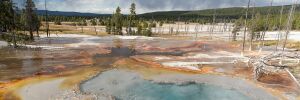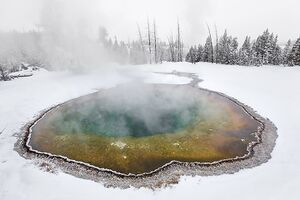Microbial organisms in Yellowstone
Section

By Sydney Srnka
At right is a sample image insertion. It works for any image uploaded anywhere to MicrobeWiki.
The insertion code consists of:
Double brackets: [[
Filename: PHIL_1181_lores.jpg
Thumbnail status: |thumb|
Pixel size: |300px|
Placement on page: |right|
Legend/credit: Electron micrograph of the Ebola Zaire virus. This was the first photo ever taken of the virus, on 10/13/1976. By Dr. F.A. Murphy, now at U.C. Davis, then at the CDC. Every image requires a link to the source.
Closed double brackets: ]]
Other examples:
Bold
Italic
Subscript: H2O
Superscript: Fe3+
Introduction
Include some current research, with at least one figure showing data.
Every point of information REQUIRES CITATION using the citation tool shown above.
The microbial community found in Yellowstone national park is extremely diverse and extensive. The wide variety of microorganisms lead to extensive and ongoing research in the park. Factors attributing to the diversity of microorganisms include the park’s range in environments with varieties of temperature, pH, and Hydrogen Sulfide levels[1]. The areas of accumulating interests include the hot springs, Thermopools, and geysers located in Yellowstone National Park. These areas sparked the interest of many researchers because there are organisms not only living, but thriving in extreme conditions such as superheated environments and underwater in anaerobic environments [2] .Some of the interesting microorganisms include, but are not limited to; Thermophilic Bacteria, Thermus Aquaticus, Caldicellulosiruptor obsidiansis, Cyanobacteria, algae, mushrooms, fungi (ex. Curvularia protuberata), and Sulfolobus Acidocaldarius[3][4]. The Thermophilic bacteria that were first discovered in the hot springs of Yellowstone increased research on this type of bacteria and led to many more new discoveries on how these extremophiles were able to survive. Because Thermophilic bacteria are able to exist in extreme temperature and pH ranges, they became very popular organisms to study, especially because they have a variety of mechanisms that are not found in other cells that have been previously studied [1].

Thermophilic Organisms
Include some current research, with at least one figure showing data.
A large quantity of organisms residing in the superheated environments are classified as Thermophiles. These organisms fall under this classification because the name means heat lover (Thermo: Heat, Phile: Lover) and the environments they are mostly found in are superheated environments[3]. Most Thermophiles fall under the bacteria and archaea domains however, there are a small number of eukaryotes that can be classified as thermophiles [5]. Thermophilic bacteria can thrive in a range of water temperatures, some environments inhabited by thermophiles even surpass the boiling point of water [6]. These bacteria have become a hot topic of research and study due to the adaptability of their metabolic processes and the process of their life functions.The reason they can survive in such conditions can be attributed to many factore, a few being that Thermophiles have adapted their proteins and DNA to be more stable and enzymes to function better in hotter environments. These adaptations are called thermo-adapted genes by scientists, and have been a recurring topic studied and researched for years [5]. The determination and classification of the adaptations also leads to the study of how and why they are accumulated and passed on. Adaptation can happen by natural selection or random mutation, the ways the adaptations are passed on and spread through a colony of archaea or bacteria can be determined by studying the history of a specific gene. One method of the transfer of adapted genes is Horizontal Gene Transfer. Horizontal Gene transfer is the passing of a gene from parent to offspring. For example, one gene that is passed from parent to offspring in Thermophilic Archaea is the gene coding for the Reverse gyrase[5]. The reverse gyrase topoisomerase helps with the DNA denaturation, it induces supercoiling of the double stranded DNA in order to increase the temperature in which the DNA can exist without denaturing or melting[5]. This adaptation is one of the factors of thermophiles that allow them to live in such extreme conditions and environments. The thermophilic genome contains a wide variety of adaptations and mutations, yet is smaller than most prokaryotic genomes [5].This is due to gene loss. The archaea and bacteria that live in these extreme environments often discard genes that they are no longer in need of or serve no function[5]. This allows the DNA to become more compact and less likely to denature at higher temperatures. Protein stability is also a large factor when it comes to being able to survive at high temperatures. In order for the protein to be more stable, the machinery that builds the protein must also be able to withstand intense heat. It is actually more important that the protein assembling machinery is able to withstand high temperatures. This is because if a protein were to denature or not be able to function properly due to the heat it could just be rebuilt. This is not the case for the protein building machinery, for these vital functioning parts of the cell there is no replacement <ref name= Brock>https://www.science.org/doi/10.1126/science.230.4722.132Cite error: The opening <ref> tag is malformed or has a bad name. Thermophilic cells also adapt to functioning at higher temperatures by adjusting the expression of their genes and how fast the enzymes work in processes such as protein synthesis, gene replication, and gene expression. For example in some organisms certain gene expression is temperature dependent, meaning that only certain segments of the DNA or gene are expressed at certain temperatures. This also means that higher temperatures can unlock expression of genes or operons [5].

Extremophilic Organisms
Include some current research, with at least one figure showing data.
Morning Glory
Historical Findings
Conclusion
References
- ↑ 1.0 1.1 Pandey, A., Dhakar, K., Sharma, A. et al. Thermophilic bacteria that tolerate a wide temperature and pH range colonize the Soldhar (95 °C) and Ringigad (80 °C) hot springs of Uttarakhand, India. Ann Microbiol 65, 809–816 (2015). https://doi.org/10.1007/s13213-014-0921-0
- ↑ Life in Extreme Heat. https://www.nps.gov/yell/learn/nature/life-in-extreme-heat.htm
- ↑ 3.0 3.1 https://blog.microbiologics.com/microorganisms-of-yellowstone-national-park/
- ↑ https://www.nps.gov/yell/learn/nature/thermophilic-eukarya.htm
- ↑ 5.0 5.1 5.2 5.3 5.4 5.5 5.6 Wang Q, Cen Z, and Zhao J, The Survival Mechanisms of Thermophiles at High Temperatures: An Angle of Omics https://journals.physiology.org/doi/full/10.1152/physiol.00066.2013#
- ↑ https://www.nps.gov/yell/learn/nature/thermophilic-bacteria.htm
Authored for BIOL 238 Microbiology, taught by Joan Slonczewski, 2022, Kenyon College
